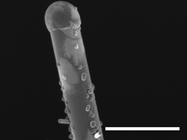Crossref Citations
This article has been cited by the following publications. This list is generated based on data provided by
Crossref.
Montero-Ocampo, C.
Garcia, J.R. Vargas
and
Estrada, E. Arce
2013.
Comparison of TiO2 and TiO2-CNT as Cathode Catalyst Supports for ORR.
International Journal of Electrochemical Science,
Vol. 8,
Issue. 12,
p.
12780.
Cao, Xiao Lu
Li, Qiao Xia
Yao, Ya Feng
and
Xu, Qun Jie
2013.
Recent Progress for TiO<sub>2</sub> as the Support of Electrocatalysts in Fuel Cell Applications.
Advanced Materials Research,
Vol. 860-863,
Issue. ,
p.
812.
Williams, Vennesa O.
DeMarco, Erica J.
Katz, Michael J.
Libera, Joseph A.
Riha, Shannon C.
Kim, Dong Wook
Avila, Jason R.
Martinson, Alex B. F.
Elam, Jeffrey W.
Pellin, Michael J.
Farha, Omar K.
and
Hupp, Joseph T.
2014.
Fabrication of Transparent-Conducting-Oxide-Coated Inverse Opals as Mesostructured Architectures for Electrocatalysis Applications: A Case Study with NiO.
ACS Applied Materials & Interfaces,
Vol. 6,
Issue. 15,
p.
12290.
Tiron, V.
Velicu, I.-L.
Dobromir, M.
Demeter, A.
Samoila, F.
Ursu, C.
and
Sirghi, L.
2016.
Reactive multi-pulse HiPIMS deposition of oxygen-deficient TiOx thin films.
Thin Solid Films,
Vol. 603,
Issue. ,
p.
255.
Niemelä, Janne-Petteri
Marin, Giovanni
and
Karppinen, Maarit
2017.
Titanium dioxide thin films by atomic layer deposition: a review.
Semiconductor Science and Technology,
Vol. 32,
Issue. 9,
p.
093005.
Fraser, Alison
Zhang, Zishuai
Merle, Geraldine
Gbureck, Uwe
Ye, Siyu
Gostick, Jeff
and
Barralet, Jake
2018.
Composite Carbon Nanotube Microsphere Coatings for Use as Electrode Supports.
Advanced Functional Materials,
Vol. 28,
Issue. 46,
Eckardt, M.
Gebauer, C.
Jusys, Z.
Wassner, M.
Hüsing, N.
and
Behm, R.J.
2018.
Oxygen reduction reaction activity and long-term stability of platinum nanoparticles supported on titania and titania-carbon nanotube composites.
Journal of Power Sources,
Vol. 400,
Issue. ,
p.
580.
